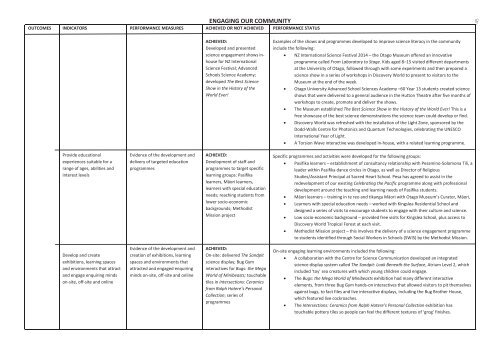OTAGO MUSEUM
OtagoMuseum-1415-Annual-Report
OtagoMuseum-1415-Annual-Report
You also want an ePaper? Increase the reach of your titles
YUMPU automatically turns print PDFs into web optimized ePapers that Google loves.
OUTCOMES<br />
INDICATORS<br />
PERFORMANCE MEASURES<br />
ENGAGING OUR COMMUNITY<br />
ACHIEVED OR NOT ACHIEVED<br />
PERFORMANCE STATUS<br />
45<br />
ACHIEVED:<br />
Developed and presented<br />
science engagement shows inhouse<br />
for NZ International<br />
Science Festival; Advanced<br />
Schools Science Academy;<br />
developed The Best Science<br />
Show in the History of the<br />
World Ever!<br />
Examples of the shows and programmes developed to improve science literacy in the community<br />
include the following:<br />
• NZ International Science Festival 2014 – the Otago Museum offered an innovative<br />
programme called From Laboratory to Stage. Kids aged 8–15 visited different departments<br />
at the University of Otago, followed through with some experiments and then prepared a<br />
science show in a series of workshops in Discovery World to present to visitors to the<br />
Museum at the end of the week.<br />
• Otago University Advanced School Sciences Academy –60 Year 13 students created science<br />
shows that were delivered to a general audience in the Hutton Theatre after five months of<br />
workshops to create, promote and deliver the shows.<br />
• The Museum established The Best Science Show in the History of the World Ever! This is a<br />
free showcase of the best science demonstrations the science team could develop or find.<br />
• Discovery World was refreshed with the installation of the Light Zone, sponsored by the<br />
Dodd-Walls Centre for Photonics and Quantum Technologies, celebrating the UNESCO<br />
International Year of Light.<br />
• A Torsion Wave interactive was developed in-house, with a related learning programme.<br />
Provide educational<br />
experiences suitable for a<br />
range of ages, abilities and<br />
interest levels<br />
Evidence of the development and<br />
delivery of targeted education<br />
programmes<br />
ACHIEVED:<br />
Development of staff and<br />
programmes to target specific<br />
learning groups: Pasifika<br />
learners, Māori learners,<br />
learners with special education<br />
needs; reaching students from<br />
lower socio-economic<br />
backgrounds; Methodist<br />
Mission project<br />
Specific programmes and activities were developed for the following groups:<br />
• Pasifika learners – establishment of consultancy relationship with Pesamino-Solomona Tili, a<br />
leader within Pasifika dance circles in Otago, as well as Director of Religious<br />
Studies/Assistant Principal at Sacred Heart School. Pesa has agreed to assist in the<br />
redevelopment of our existing Celebrating the Pacific programme along with professional<br />
development around the teaching and learning needs of Pasifika students.<br />
• Māori learners – training in te reo and tikanga Māori with Otago Museum’s Curator, Māori,<br />
• Learners with special education needs – worked with Kingslea Residential School and<br />
designed a series of visits to encourage students to engage with their culture and science.<br />
• Low socio-economic background – provided free visits for Kingslea School, plus access to<br />
Discovery World Tropical Forest at each visit.<br />
• Methodist Mission project – this involves the delivery of a science engagement programme<br />
to students identified through Social Workers in Schools (SWIS) by the Methodist Mission.<br />
Develop and create<br />
exhibitions, learning spaces<br />
and environments that attract<br />
and engage enquiring minds<br />
on-site, off-site and online<br />
Evidence of the development and<br />
creation of exhibitions, learning<br />
spaces and environments that<br />
attracted and engaged enquiring<br />
minds on-site, off-site and online<br />
ACHIEVED:<br />
On-site: delivered The Sandpit<br />
science display; Bug Gym<br />
interactives for Bugs: the Mega<br />
World of Minibeasts; touchable<br />
tiles in Intersections: Ceramics<br />
from Ralph Hotere’s Personal<br />
Collection; series of<br />
programmes<br />
On-site engaging learning environments included the following:<br />
• A collaboration with the Centre for Science Communication developed an integrated<br />
science display system called The Sandpit: Look Beneath the Surface, Atrium Level 2, which<br />
included ‘toy’ sea creatures with which young children could engage.<br />
• The Bugs: the Mega World of Minibeasts exhibition had many different interactive<br />
elements, from three Bug Gym hands-on interactives that allowed visitors to pit themselves<br />
against bugs, to fact files and live interactive displays, including the Bug Brother House,<br />
which featured live cockroaches.<br />
• The Intersections: Ceramics from Ralph Hotere’s Personal Collection exhibition has<br />
touchable pottery tiles so people can feel the different textures of ‘grog’ finishes.


